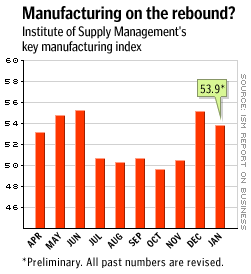NEW YORK (CNN/Money) -
After a bumpy recovery from a long slump, manufacturing finally seems to be on the mend -- a hopeful sign for the broader economy -- but the 2 million people the sector's laid off in recent years shouldn't expect to get new factory jobs anytime soon.
While a closely watched index of manufacturing activity edged lower in January, according to an industry report Monday, the sector still grew, though at a slower rate than in December.
What's more, manufacturing activity expanded every month last year save for two, January and October, and the recent spate of strength has come despite the looming prospect of war in Iraq, which Federal Reserve Chairman Alan Greenspan and other economists think has restrained business spending.

"Manufacturing seems to be accelerating into the potential war situation, and that is a positive signal that this time the recovery will be long-lasting," said Joel Naroff, president and chief economist of Naroff Economic Advisors.
Regional manufacturing measures such as the Chicago Purchasing Managers Index, the New York Federal Reserve's Empire State Manufacturing Survey and the Philadelphia Fed's survey of business optimism in Pennsylvania, New Jersey and Delaware, have reinforced the view that the sector is gathering strength.
And unlike lots of government economic reports -- which are sometimes wildly volatile, skewed by seasonal adjustments or sharply revised every few months -- many economists think the ISM report is not only reliable, but could be a good indicator of the economy's general direction.
While orders for U.S. manufactured goods total about $3.5 trillion a year -- compared to the $10 trillion total U.S. economy -- the ISM says that a reading of 53.9 translates to an annual growth rate of 4 percent in gross domestic product (GDP), the broadest measure of the nation's economy, and many economists agree.
"Historically this number tracks the economy, in general, pretty well," said UBS Warburg senior economist Jim O'Sullivan. "And of all the numbers, this report really has almost the least amount of noise."
Though O'Sullivan and other economists warned first-quarter GDP will not track ISM perfectly, GDP growth anywhere near 4 percent would be a far sight better than the anemic 0.7 percent growth rate for the economy in the fourth quarter.
No champagne just yet
Despite the good news, manufacturers, who suffered through an 18-month slump between August 2000 and January 2002, then another mini-slump in the late summer of 2002, weren't popping champagne corks just yet.
"It's a good number, but we're reluctant to read much great significance into it," said Hank Cox, spokesman for the National Association of Manufacturers, which has been a vocal supporter of President Bush's economic stimulus proposals.
Many economists were quick to note that the falling dollar, which makes U.S. goods more competitive overseas, may have helped manufacturers at the end of last year.
While that's good news for the sector, it undercuts somewhat the argument that the improving ISM index means the broader economy is set for lift-off, since the falling dollar is partially the result of international concerns about the U.S. role in Iraq, falling stock prices and other negative factors.
"We would hope that [the ISM] is sending the correct signal, and the details suggest it is; but it's wise, given the fact that businesses are being cautious about investing, to wait until this result is validated [by other data]," said Nick Bennenbroek, international economist at Brown Brothers Harriman.
Bennenbroek and other economists are concerned that manufacturing and the rest of the economy still have too much production capacity, the hangover from an orgy of spending on technology and factory improvements in the late 1990s.
If that's really what's holding the economy back -- more than any worries about Iraq -- the economy could be in the doldrums for some time, since such excesses could take several more months to clear up.
Forget those factory jobs
In any event, when businesses are ready to start ramping up production, they might not feel the need to do much hiring, since they've learned during the downturn how to milk more work out of fewer workers.
"Productivity growth helps keep inflation at bay and allows real incomes to grow, but it makes businesses even slower to hire than usual," said former Federal Reserve economist Wayne Ayers, now chief economist at Fleet Boston Financial, who thinks job-market stability might not come until the end of 2003.

During the 18-month slump in 2000 and 2001, manufacturers cut nearly 1.6 million jobs, and though the sector recovered last year, another half-million jobs got cut last year.
The ISM says its employment index needs to stay above 47.8 for a while just to have stability in manufacturing employment, much less job growth. The sub-index only climbed above 47.8 once in all of 2002; it's close to that level now, but not there yet.
"The manufacturing sector is so productive that even with a rebound in production and orders, we still have, at best, flat employment," said Putnam Investments economist David Kelly. "This is encouraging, but manufacturing employment remains a sore point in the American economy."
In fact, it might always be a sore point in the economy. Even as manufacturing's importance has shrunk relative to the rest of the economy, developing nations such as China and India have been offering super-cheap manufacturing labor for years, making the market for factory jobs even more bleak. As a result, manufacturing employment has fallen every year since 1997.
"In many cases, people who've been laid off in manufacturing should not look to manufacturing to replace their jobs," Kelly said. "It's not going to happen."

|

